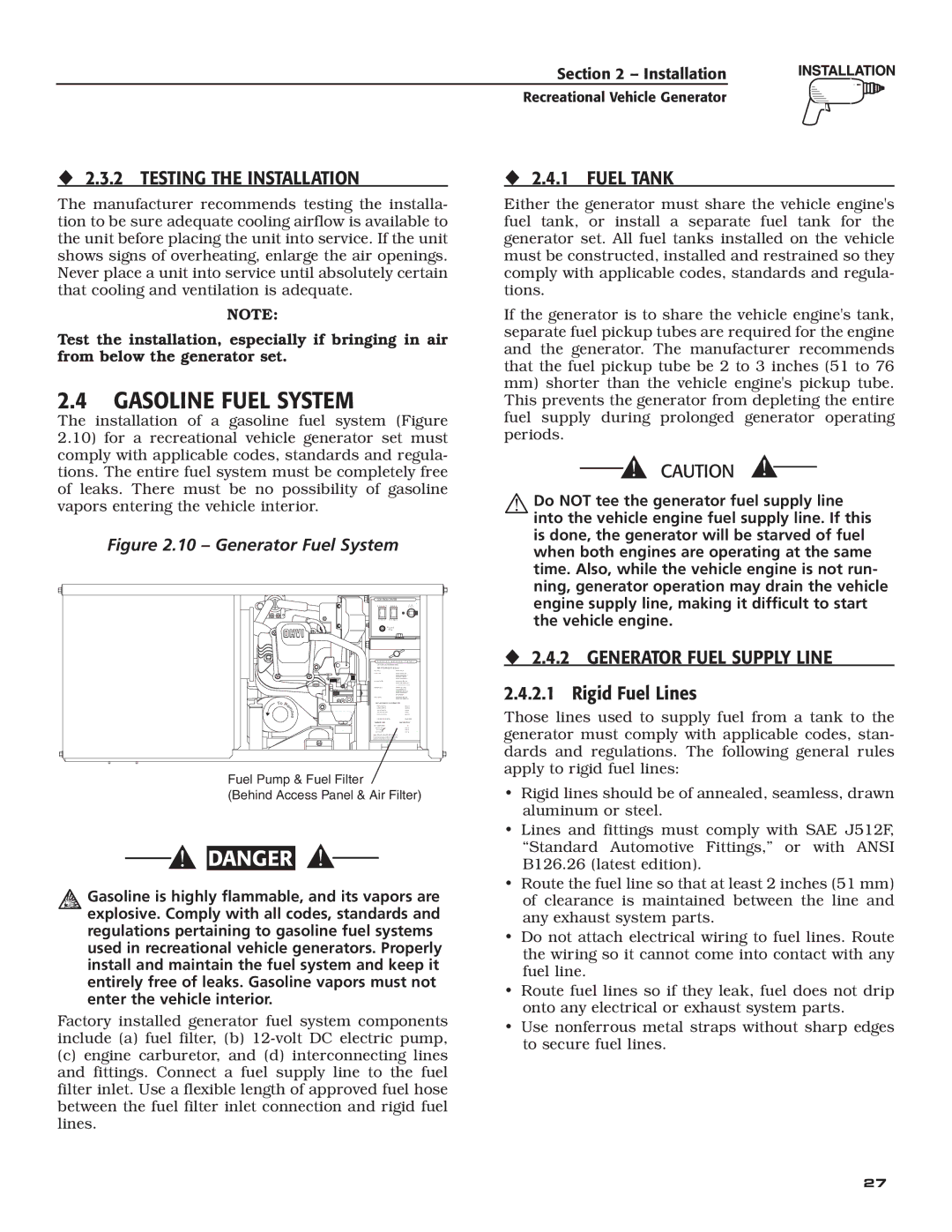
Section 2 – Installation
Recreational Vehicle Generator
2.3.2 TESTING THE INSTALLATION
The manufacturer recommends testing the installa- tion to be sure adequate cooling airflow is available to the unit before placing the unit into service. If the unit shows signs of overheating, enlarge the air openings. Never place a unit into service until absolutely certain that cooling and ventilation is adequate.
NOTE:
Test the installation, especially if bringing in air from below the generator set.
2.4 GASOLINE FUEL SYSTEM
The installation of a gasoline fuel system (Figure 2.10) for a recreational vehicle generator set must comply with applicable codes, standards and regula- tions. The entire fuel system must be completely free of leaks. There must be no possibility of gasoline vapors entering the vehicle interior.
Figure 2.10 – Generator Fuel System
|
|
|
| CONTROL CENTER |
| |
|
|
|
| S T A R T | F U E L | C . B . |
|
|
|
| 3 0 A | ||
|
|
|
| S T O P | P R I M E |
|
|
|
|
|
| F U S E |
|
|
|
|
|
| 7.5 A |
|
|
|
|
| S E R V IC E A C C E S S P A N E L | ||
|
|
|
| MAINTENANCE SCHEDULE |
| |
GENERAC |
|
|
|
| ||
OHVIPOWERED |
| I | REPLACEMENT INFORMATION | |||
G E N E R A C | P o w e r S y s t e m s , I n c .- W h it ew | a t e r , W |
| To Re |
|
|
|
|
| m |
|
| |
|
|
|
| o |
|
|
|
|
|
| v |
|
|
|
|
|
| e |
|
|
|
|
|
| TEMPERATURE |
| SAE VISCOSITY |
| GENERAC OHVI INDUSTRIAL ENGINE |
|
| |||
QUIETPACT 40G |
|
| ||||
|
| RV SERVICE LOCATOR: | 1.800.333.1322 |
|
| |
Fuel Pump & Fuel Filter
(Behind Access Panel & Air Filter)
![]()
![]() DANGER
DANGER
Gasoline is highly flammable, and its vapors are explosive. Comply with all codes, standards and regulations pertaining to gasoline fuel systems used in recreational vehicle generators. Properly install and maintain the fuel system and keep it entirely free of leaks. Gasoline vapors must not enter the vehicle interior.
Factory installed generator fuel system components include (a) fuel filter, (b)
(c)engine carburetor, and (d) interconnecting lines and fittings. Connect a fuel supply line to the fuel filter inlet. Use a flexible length of approved fuel hose between the fuel filter inlet connection and rigid fuel lines.
2.4.1 FUEL TANK
Either the generator must share the vehicle engine's fuel tank, or install a separate fuel tank for the generator set. All fuel tanks installed on the vehicle must be constructed, installed and restrained so they comply with applicable codes, standards and regula- tions.
If the generator is to share the vehicle engine's tank, separate fuel pickup tubes are required for the engine and the generator. The manufacturer recommends that the fuel pickup tube be 2 to 3 inches (51 to 76
mm)shorter than the vehicle engine's pickup tube. This prevents the generator from depleting the entire fuel supply during prolonged generator operating periods.
Do NOT tee the generator fuel supply line into the vehicle engine fuel supply line. If this is done, the generator will be starved of fuel when both engines are operating at the same time. Also, while the vehicle engine is not run- ning, generator operation may drain the vehicle engine supply line, making it difficult to start the vehicle engine.
2.4.2 GENERATOR FUEL SUPPLY LINE
2.4.2.1 Rigid Fuel Lines
Those lines used to supply fuel from a tank to the generator must comply with applicable codes, stan- dards and regulations. The following general rules apply to rigid fuel lines:
•Rigid lines should be of annealed, seamless, drawn aluminum or steel.
•Lines and fittings must comply with SAE J512F, “Standard Automotive Fittings,” or with ANSI B126.26 (latest edition).
•Route the fuel line so that at least 2 inches (51 mm) of clearance is maintained between the line and any exhaust system parts.
•Do not attach electrical wiring to fuel lines. Route the wiring so it cannot come into contact with any fuel line.
•Route fuel lines so if they leak, fuel does not drip onto any electrical or exhaust system parts.
•Use nonferrous metal straps without sharp edges to secure fuel lines.
27
